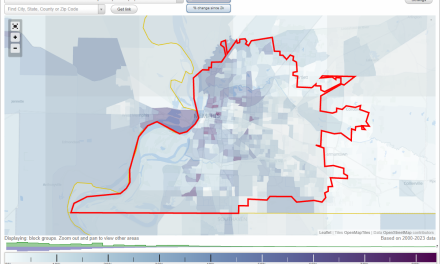It is not possible to think of a place in Memphis that more deserves a Tax Increment Financing (TIF) district than Binghamton.
In fact, it’s been 11 years in the making. That’s how long ago it was that a charrette – the Broad Avenue Planning Initiative – was held to consider how the area could be the neighborhood that serves as the exemplar for smart revitalization.
Over those 11 years, Broad Avenue and its symbiotic relationship with its neighborhood, Binghamton, has only grown deeper, and these days, it is hard to imagine the success of one without the success of the other. A TIF offers an opportunity to prove just how true this is, but it also gives an opportunity for Broad Avenue businesses to move into the future with assurances that their founding principles and vision remain intact.
It’s nothing short of amazing what these urban pioneers have done in just over a dozen years. They have not just stabilized a once-proud neighborhood, but they did it in a distinctly urban way, paying tribute to the authentic strengths of the area and resisting the tendency to “suburbanize” the street.
Being True To The Ethos
This tendency has squandered opportunities for developments all over Memphis, and if city government wants to help, it can strongly support a Broad Avenue/Binghamton TIF with the proviso that investors in the neighborhood will not have carte blanche to do whatever they want and instead, they must honor the fabric of the neighborhood but just as much, they must honor the ethos that has made it what it is today.
Noah Gray, executive director of the Binghampton Development Corporation, said it well: “It’s really a unique opportunity to model neighborhood redevelopment that is driven by priorities straight from the neighborhood…this is an opportunity for the poor to thrive and to drive their vision for their improved quality of life instead of it being developer-driven.”
Led by Pat Brown, art gallery owner and TIF committee member, Broad Avenue has received a $120,000 Kresge Foundation grant aimed at hitting the sweet spot: growing the commercial district without driving up rents that force out the small businesses that have made the renaissance there possible.
Already, 16 developments are planned in the district, and with this increased tax base, the TIF – which captures the incremental growth in the property taxes that results from the new developments – is projected to have $26.2 million to invest over 30 years. That could fund $9.2 million in housing and neighborhood development; $8.5 million in infrastructure improvements; $3.2 million investment in public facilities; $3.27 million in environmental improvements and site acquisition; and $2 million in equitable economic development projects in the community.
Making The Most of TIFs
The decision rests with the joint city-county Community Redevelopment Agency, which has an elevated stature since being pulled out of the respective bureaucracies of local governments to answer to the mayors’ offices. Memphis Mayor Jim Strickland and Shelby County Mayor Mark Luttrell said at the time that they believe that the CRA can play a bigger role in encouraging development through the use of the underused TIF tool. (Hopefully, in time, more of the CRA members can come from neighborhoods and less from the legal community.)
As we’ve said before, we prefer the TIF over the PILOT. With TIFs, the development is paying for its public costs with the increase in property taxes that result from it. With PILOTs, the beneficiaries have the majority of their property tax bills shifted to homeowners and small businesses.
Right now, at least four new TIF districts are being considered by the city administration, but it’s hard to think of any that should be ahead of Binghamton/Broad Avenue.
Here’s the blog post we wrote April 17, 2006:
Broad Avenue Plan Cries Out For TIF
If there’s ever been a justification to create another TIF (tax increment financing) district in Memphis, we need wait no more. The Broad Avenue Corridor Planning Initiative gives us a powerful reason to act.
This seems especially timely to us, because a couple of weeks ago, we advocated that Memphis and Shelby County use the TIF as a way to decrease the overreliance on tax freezes by the Industrial Development Board and Center City Revenue Finance Corporation.
Like most taxpayers, we have been impatiently waiting on city and county governments to implement the recommendations from the well-reasoned consultant’s report about the current PIILOT (payment-in-lieu-of-taxes) program. The consultants made a compelling case that should have created a sense of urgency by our public leaders, but it was not to be, because of the powerful real estate interests arrayed in opposition to some of the key recommendations of the report.
In a presentation some weeks ago by the consultants, one comment went unreported, but has special meaning for Broad Avenue. At that time, the consultants said that downtown Memphis seemed to have the momentum for a sustained recovery, and perhaps it is time to shift the focus of tax freezes from downtown to neighborhoods where they are more needed.
Broad Avenue would certainly head that list. The planning initiative to be unveiled tomorrow night (Tuesday) is the most impressive in recent history.
Broad Avenue As Urban Case Study
The plan paints the portrait of an entirely new Binghamton, one that becomes an anchor for redevelopment and a model for the principles embraced in the new unified development code being written by the Office of Planning and Development.
And that’s why the Broad Avenue plan has even more importance than first meets the eye.
The same consultants writing the unified development code developed the plan for Binghamton, continuing the progressive thinking that has characterized their work so far.
They wrote in the Broad Avenue report: “The current development regulations in place today reflect a previous desire to ‘suburbanize’ the city and county with larger lot sizes, and development standards that reflect an auto-dominated environment. As part of the unified development code process, a set of more urban, mixed use, pedestrian-friendly development standards has been developed. The Broad Avenue Corridor area was selected to test the ability of the new regulations to effectively implement these improved standards. The lessons learned from the planning process will be incorporated into the larger Unified Development Code.”
Well-said.
Common Sense
From the beginning, the consultants writing the unified code have laid a foundation that can make the code a model for the country, shifting our community from a sprawl at any cost community to a more environmentally sensitive, more walkable, more mixed use view of the future.
Even without the ties to the unified code, the Broad Avenue Planning Initiative would be historic in its own right. Directed by Louise Mercuro of OPD, who always manages to inject innovation and aspiration into city/county planning projects, the initiative should mark the rebirth of the neighborhood destroyed by the highway (then intended as the I-40 route through Memphis and now Sam Cooper Boulevard) that carved it into two pieces and ripped its soul into even more.
To see the area now, it’s hard to believe that in 1956, it had three grocery stores, three dry goods stores, three doctors, a dentist, a civil engineer’s office, a lawyer’s office, several restaurants, a shoe repair shop, a barbershop and a handful of light industries. In other words, it was a functioning neighborhood. That ended in the late 1960s when the road construction displaced more than 200 residents.
Priorities
So, how does the plan seek to solve this problem?
The plan intends 1) To reconnect the surrounding neighborhoods; 2) To promote diversity, mix uses, and mix incomes; 3) To make the streets more walkable; 4) To make it easy to build the right thing; and 5) To control the scale of new development.
To achieve these goals, the planning initiative proposed, among other things, a grand pedestrian gateway into Overton Park, public gardens and common spaces for the neighborhood, landscaping to make the area more walkable, diagonal parking to support businesses, new at-grade intersections crossing Sam Cooper Blvd., a shift from high-speed thoroughfares to walkable boulevards, and sidewalks safely located a distance from the road.
There are recommendations for retail and service businesses (such as a 40,000 square foot grocery store), lofts, senior housing and new housing.
Back to our original point about tax increment financing, there’s no better place for TIF district than in pursuit of this vision for Broad Avenue. In fact, it’s almost a textbook justification – it has a clear plan, it has mixed use with every type of land use and person, it is in dire need of infrastructure improvements such as sidewalks and streetscapes, it has right-of-way that can be sold to create new taxes for the TIF district, and it has some solid civic anchors such as the new school and new police precinct.
Looking Beyond PILOTs
TIFs are now authorized in 47 states, and although they’re regulated by the state, they’re actually controlled by city governments to help redevelop areas that are deemed “blighted.” When an area is redeveloped, it creates new property taxes. From these taxes, the original property taxes (based on the unimproved values) are paid to the city and county, and the balance (the tax increment) goes into a special fund to pay debt service on bonds for the infrastructure. Usually, TIF pays for streets, sewers, parking facilities, land acquisition, planning expenses, job training, demolition and clean-up costs.
Tax increment financing is not perfect. No business incentive is, but it’s time to look beyond PILOTs to a time when we have a more balanced, diverse mix of business incentives in Memphis and Shelby County. Tax increment financing didn’t get anywhere last time it was discussed by local legislative bodies, but perhaps, with some much-needed controls put in place on the PILOT program, it’s time to revisit it.
**
Join us at the Smart City Memphis Facebook page for daily articles, reports, and commentaries relevant to Memphis.






Why single out that one area? This whole city is literally falling apart and needs help.
It’s not just about areas that are “falling apart” because there has to be the potential for the investment to increase property tax revenues that in turn pay for the public investment. As a result, it helps if there are assets and strengths that exist that can be leveraged for greater vitality.
What about Soulsville? It seems it is a redevelopment waiting to happen?
Redevelopment of any type I n Memphis has always been slow and very prone to risk with decades of failed projects. The returns just aren’t there. Yet another of the many reasons the local economy has always been sub par. There is far more money and better prospects for return in other cities.
38103: Soulsville has been mentioned previously as a TIF target, but as far as we know, no one has done the ground work and research to write up an application. That said, we may be wrong.
Anonymous: Your comment is irrelevant. This is money being generated her by a development based on a third party evaluation and it can only be spent here. It’s not like this is an investment that is mobile.
All of Downtown Memphis is in dire need of redevelopment
Some years ago, a TIF was proposed for downtown by City of Memphis and also by Downtown Memphis Commission. It seemed to us that competing uses killed it off for either.
The TIF is the most appropriate funding source for the Broad Avenue Arts (and Entertainment) district. There is no other comprehensive planning/zoning project in Memphis that has achieved what Bingham(p)ton has realized in a short 11 years. I count it as one of my most proud projects. Thanks to the residents, the landowners, the businesses, the City Council and County Commision and the hardworking people of the Division of Planning and Development and every, and I mean every, division of Memphis City Government. The local support and involvement was unprecedented. There should be no question about approving and implementing a TIF fr Broad.